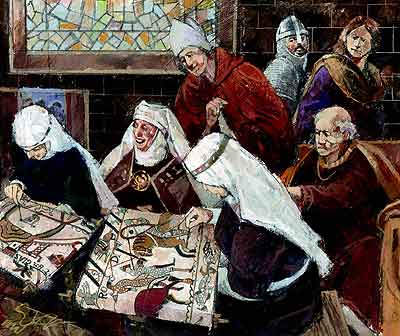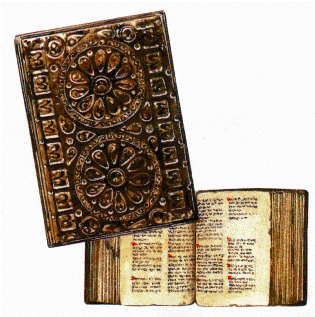Medieval History
The term Middle Ages refers mainly to the history of
Christian and
Jewish Europe between the
fall of Rome and the
Renaissance, around 400-1500
AD.
Historians usually divide this into three smaller periods, the Early
Middle Ages, the High Middle Ages, and the Late Middle Ages.
The Norman Conquest

"Harold Rex interfectus est" - King Harold is killed
(Bayeux Tapestry)
Around 1000 AD, some of the Vikings who had been raiding France got permission from the French king to settle down and live in France instead. They were supposed to help protect France against other Vikings (as the Visigoths had done before). As part of the deal, these Vikings also converted from their German gods to Catholicism. These settlers were called the Normans (which is short for North-Men, because they came from the North). The part of France where they lived is called Normandy, the land of the North-Men, even today.

Click this to watch an animated version of the Bayeux
tapestry showing the invasion of England.
(You
might need to paste the URL into a new browser page of right mouse
click and select 'open link in a new window'.)
After a while, though, the children and grandchildren of these Vikings were tired of just living in Normandy and farming, and wanted some adventure and a chance to increase their wealth. In 1066 AD, one of these men, William, decided to attack England and try to conquer it from the Anglo-Saxons. William's mother had not been married to his father when he was born, but William still inherited his father's property and his title of Duke of Normandy. People called him William the Bastard (that means that his parents were not married). He wanted to do something big and adventurous, and when Edward, the King of England died without leaving a son, William thought he saw a chance to take over England.
William also claimed that King Edward, who had spent much of his time living in Normandy, had promised William the throne. So William sailed across the English Channel in a lot of small boats, and when they got there they did beat the Anglo-Saxons in the battle of Hastings. The Anglo-Saxon king, Harold, was shot in the eye with an arrow and died.

William (who was now called William
the Conqueror) became the new king of England. He was crowned in
Westminster Abbey. He built the
Tower of London to live in, to keep himself and his family safe.
William and all his friends spoke French, but the English people spoke
Saxon. So for a long time there were two languages spoken in England.
(From:
http://www.historyforkids.org/learn/medieval/history/history.htm)
At Christmas 1085 William ordered a survey of his
kingdom. He needed to know how much tax he could expect to
collect. He appointed people out to every hamlet in the country. Their
job was to count every pig, every person, every farm, every rooster in
the kingdom. Their reports were entered in a book called the Domesday
Book. It was the first census since Roman times.(http://medievaleurope.mrdonn.org/normanconquest.html) The clerks introduced the word ‘manor’, at
this time simply meaning the dwelling of an important person. It is a
unique surviving record. (http://www.essentialnormanconquest.com/story/way-of-life.htm)


Click the Dooms Day book to find out who became King after William the Conqueror.